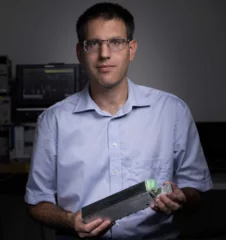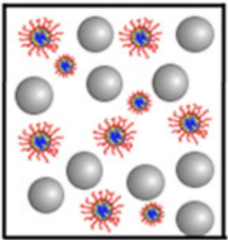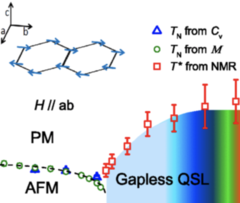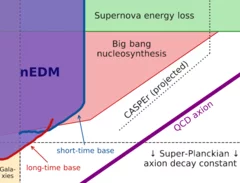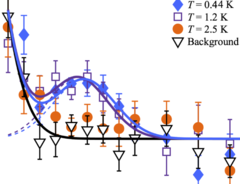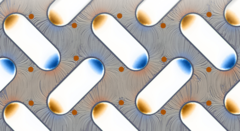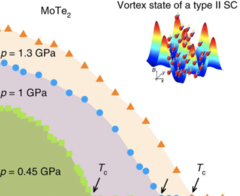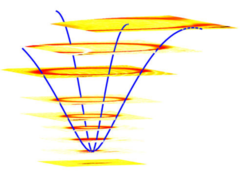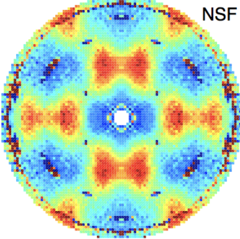NUM division - Publication Highlights
Jean-Baptiste Mosset winner of PSI Founder Fellowship
Jean-Baptiste Mosset from the Laboratory of Particle Physics is the winner of a PSI Founder Fellowship and plans now to commercialise a neutron detector to spot plutonium and uranium. With his new technology, less expensive and more efficient neutron detectors could be developed. In the next 18 months, Mosset wants to further develop his prototype and find out if demand for this technology exists in industry.
Tuning Nanoparticle–Micelle Interactions and Resultant Phase Behavior
The evolution of the interaction between an anionic nanoparticle and a nonionic surfactant and their resultant phase behavior in aqueous solution in the presence of electrolyte and ionic surfactants have been studied. The mixed system of anionic silica nanoparticles (Ludox LS30) with nonionic surfactant decaethylene glycol monododecylether (C12E10) forms a highly stable clear phase over a wide concentration range of surfactant.
Gapless Spin Excitations in the Field-Induced Quantum Spin Liquid Phase of α-RuCl3
α-RuCl3 is a leading candidate material for the observation of physics related to the Kitaev quantum spin liquid (QSL). By combined susceptibility, specific-heat, and nuclear-magnetic-resonance measurements, we demonstrate that α-RuCl3 undergoes a quantum phase transition to a QSL in a magnetic field of 7.5 T applied in the ab plane. We show further that this high-field QSL phase has gapless spin excitations over a field range up to 16 T.
Search for Axionlike Dark Matter through Nuclear Spin Precession in Electric and Magnetic Fields
We report on a search for ultralow-mass axionlike dark matter by analyzing the ratio of the spin-precession frequencies of stored ultracold neutrons and 199Hg atoms for an axion-induced oscillating electric dipole moment of the neutron and an axion-wind spin-precession effect. No signal consistent with dark matter is observed for the axion mass range 10-24 ≤ ma ≤ 10-17eV.
Spin Resonance and Magnetic Order in an Unconventional Superconductor
Unconventional superconductivity in many materials is believed to be mediated by magnetic fluctuations. It is an open question how magnetic order can emerge from a superconducting condensate and how it competes with the magnetic spin resonance in unconventional superconductors. Here we study a model d-wave superconductor that develops spin-density wave order, and find that the spin resonance is unaffected by the onset of static magnetic order.
Emergent dynamic chirality in a thermally driven artificial spin ratchet
Modern nanofabrication techniques have opened the possibility to create novel functional materials, whose properties transcend those of their constituent elements. In particular, tuning the magnetostatic interactions in geometrically frustrated arrangements of nanoelements called artificial spin ice can lead to specific collective behaviour, including emergent magnetic monopoles, charge screening and transport, as well as magnonic response.
Signatures of the topological s+- superconducting order parameter in the type-II Weyl semimetal Td-MoTe2
In its orthorhombic Td polymorph, MoTe2 is a type-II Weyl semimetal, where the Weyl fermions emerge at the boundary between electron and hole pockets. Non-saturating magnetoresistance and superconductivity were also observed in Td-MoTe2. Understanding the superconductivity in Td-MoTe2, which was proposed to be topologically non-trivial, is of eminent interest.
MultiFLEXX - The new multi-analyzer at the cold triple-axis spectrometer FLEXX
The first experimental characterization of a multiple energy analysis wide angle backend for a cold triple-axis spectrometer is reported. The multi-analyzer module MultiFLEXX employs 155 detection channels which simultaneously probe an extensive range in wavevector and energy transfer. Successful mapping of magnetic excitations in MnF2 and Ho demonstrate order of magnitude gains in data collection efficiency using this novel type backend.
Coulomb spin liquid in anion-disordered pyrochlore Tb2Hf2O7
The charge ordered structure of ions and vacancies characterizing rare-earth pyrochlore oxides serves as a model for the study of geometrically frustrated magnetism. The organization of magnetic ions into networks of corner-sharing tetrahedra gives rise to highly correlated magnetic phases with strong fluctuations, including spin liquids and spin ices. It is an open question how these ground states governed by local rules are affected by disorder.
